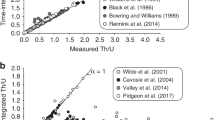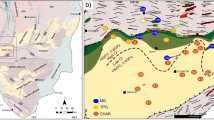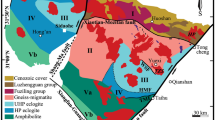Abstract
The most active icy worlds such as Europa or Enceladus are predicted to host extensive aqueous alteration driven by water–rock interactions at elevated temperatures1,2,3. On the other hand, it is assumed that such alteration is kinetically inhibited at the subzero temperatures of other icy worlds, such as the mid-sized moons of Saturn and Uranus or trans-Neptunian objects1,4. Here we perform aqueous alteration experiments on a chondrite-analogue material (olivine) and find that chemical alteration processes are still efficient at temperatures as low as −20 °C, as the presence of an unfrozen water film still allows olivine to dissolve in partially frozen alkaline solutions. We infer that aqueous alteration may be enhanced by salts and ammonia present in icy worlds, and therefore remains a geologically rapid process even at subzero temperatures. Our results imply that the primary chondritic minerals in most icy bodies exceeding 400–500 km in diameter will be completely altered to hydrous secondary minerals early in their evolutionary histories.
This is a preview of subscription content, access via your institution
Access options
Access Nature and 54 other Nature Portfolio journals
Get Nature+, our best-value online-access subscription
$29.99 / 30 days
cancel any time
Subscribe to this journal
Receive 12 digital issues and online access to articles
$119.00 per year
only $9.92 per issue
Buy this article
- Purchase on Springer Link
- Instant access to full article PDF
Prices may be subject to local taxes which are calculated during checkout



Similar content being viewed by others
Data availability
The data that support the plots in Fig. 2 are provided in the Supplementary Information. These and all other data that support the figures, table and other findings of this study are available from the corresponding author upon reasonable request.
Change history
10 March 2022
In the version of this article initially published, an extraneous black overlay appeared beneath the colored atoms in Fig. 3b and has now been removed for clarity.
References
Vance, S. D. & Melwani Daswani, M. Serpentinite and the search for life beyond Earth. Philos. Trans. R. Soc. A 378, 20180421 (2020).
Waite, J. et al. Cassini finds molecular hydrogen in the Enceladus plume: evidence for hydrothermal processes. Science 356, 155–159 (2017).
Hsu, H.-W. et al. Ongoing hydrothermal activities within Enceladus. Nature 519, 207–210 (2015).
Malamud, U. & Prialnik, D. Modeling Kuiper belt objects Charon, Orcus and Salacia by means of a new equation of state for porous icy bodies. Icarus 246, 21–36 (2015).
Malamud, U. & Prialnik, D. A 1-D evolutionary model for icy satellites, applied to Enceladus. Icarus 268, 1–11 (2016).
Palguta, J., Schubert, G. & Travis, B. J. Fluid flow and chemical alteration in carbonaceous chondrite parent bodies. Earth Planet. Sci. Lett. 296, 235–243 (2010).
Guilbert-Lepoutre, A., Prialnik, D. & Métayer, R. in The Trans-Neptunian Solar System 183–201 (Elsevier, 2020).
Ohnishi, I. & Tomeoka, K. Hydrothermal alteration experiments of enstatite: implications for aqueous alteration of carbonaceous chondrites. Meteorit. Planet. Sci. 42, 49–61 (2007).
Sekine, Y. et al. High-temperature water–rock interactions and hydrothermal environments in the chondrite-like core of Enceladus. Nat. Commun. 6, 8604 (2015).
Marion, G. M. & Kargel, J. S. Cold Aqueous Planetary Geochemistry with FREZCHEM: from Modeling to the Search for Life at the Limits (Springer, 2007).
Marion, G., Kargel, J., Catling, D. & Lunine, J. Modeling ammonia–ammonium aqueous chemistries in the Solar System’s icy bodies. Icarus 220, 932–946 (2012).
Hausrath, E. & Brantley, S. L. Basalt and olivine dissolution under cold, salty, and acidic conditions: what can we learn about recent aqueous weathering on Mars? J. Geophys. Res. Planets 115, E12001 (2010).
Niles, P. B., Michalski, J., Ming, D. W. & Golden, D. Elevated olivine weathering rates and sulfate formation at cryogenic temperatures on Mars. Nat. Commun. 8, 998 (2017).
Pokrovsky, O. S. & Schott, J. Kinetics and mechanism of forsterite dissolution at 25 °C and pH from 1 to 12. Geochim. Cosmochim. Acta 64, 3313–3325 (2000).
Rimstidt, J. D., Brantley, S. L. & Olsen, A. A. Systematic review of forsterite dissolution rate data. Geochim. Cosmochim. Acta 99, 159–178 (2012).
Anderson, D. M. The interface between ice and silicate surfaces. J. Colloid Interface Sci. 25, 174–191 (1967).
Barer, S., Churaev, N., Derjaguin, B., Kiseleva, O. & Sobolev, V. Viscosity of nonfreezing thin interlayers between the surfaces of ice and quartz. J. Colloid Interface Sci. 74, 173–180 (1980).
Rietmeijer, F. J. A model for diagenesis in proto-planetary bodies. Nature 313, 293–294 (1985).
Dickinson, W. W. & Rosen, M. R. Antarctic permafrost: an analogue for water and diagenetic minerals on Mars. Geology 31, 199–202 (2003).
Park, R. et al. A partially differentiated interior for (1) Ceres deduced from its gravity field and shape. Nature 537, 515–517 (2016).
Iess, L. et al. The gravity field and interior structure of Enceladus. Science 344, 78–80 (2014).
Zannoni, M., Hemingway, D., Casajus, L. G. & Tortora, P. The gravity field and interior structure of Dione. Icarus 345, 113713 (2020).
Bach, W. Some compositional and kinetic controls on the bioenergetic landscapes in oceanic basement. Front. Microbiol. 7, 107 (2016).
Běhounková, M. et al. Tidally induced magmatic pulses on the oceanic floor of Jupiter’s moon Europa. Geophys. Res. Lett. 48, e2020GL090077 (2021).
Affholder, A., Guyot, F., Sauterey, B., Ferrière, R. & Mazevet, S. Bayesian analysis of Enceladus’s plume data to assess methanogenesis. Nat. Astron. 5, 805–814 (2021).
Brunetto, R. & Lantz, C. Laboratory perspectives on sample returns from Hayabusa2 and OSIRIS-REx. Nat. Astron. 3, 290–292 (2019).
Marchi, S. et al. An aqueously altered carbon-rich Ceres. Nat. Astron. 3, 140–145 (2019).
Choblet, G. et al. Powering prolonged hydrothermal activity inside Enceladus. Nat. Astron. 1, 841–847 (2017).
O’Hanley, D. S. Serpentinites: Records of Tectonic and Petrological History (Oxford University Press on Demand, 1996).
Rubin, A. E., Trigo-Rodríguez, J. M., Huber, H. & Wasson, J. T. Progressive aqueous alteration of CM carbonaceous chondrites. Geochim. Cosmochim. Acta 71, 2361–2382 (2007).
Rubin, A. E. Size–frequency distributions of chondrules in CO3 chondrites. Meteoritics 24, 179–189 (1989).
Zolotov, M. Y. An oceanic composition on early and today’s Enceladus. Geophys. Res. Lett. 34, L23203 (2007).
Glein, C. R., Baross, J. A. & Waite, J. The pH of Enceladus’ ocean. Geochim. Cosmochim. Acta 162, 202–219 (2015).
Miller, H. M. et al. Modern water/rock reactions in Oman hyperalkaline peridotite aquifers and implications for microbial habitability. Geochim. Cosmochim. Acta 179, 217–241 (2016).
Lafay, R., Fernandez-Martinez, A., Montes-Hernandez, G., Auzende, A. L. & Poulain, A. Dissolution–reprecipitation and self-assembly of serpentine nanoparticles preceding chrysotile formation: insights into the structure of protoserpentine. Am. Mineral. 101, 2666–2676 (2016).
Ball, J. & Nordstrom, D. User’s Manual for WATEQ4F, with Revised Thermodynamic Data Base and Test Cases for Calculating Speciation of Major, Trace, and Redox Elements in Natural Waters 189 (US Geological Survey, 1991).
Schaffer, M., Schaffer, B. & Ramasse, Q. Sample preparation for atomic-resolution STEM at low voltages by FIB. Ultramicroscopy 114, 62–71 (2012).
Lazić, I., Bosch, E. G. & Lazar, S. Phase contrast STEM for thin samples: integrated differential phase contrast. Ultramicroscopy 160, 265–280 (2016).
Bosch, E. G. & Lazić, I. Analysis of HR-STEM theory for thin specimen. Ultramicroscopy 156, 59–72 (2015).
Daval, D. et al. Influence of amorphous silica layer formation on the dissolution rate of olivine at 90 °C and elevated pCO2. Chem. Geol. 284, 193–209 (2011).
Acknowledgements
We acknowledge financial support from the French Agence Nationale de Recherche, project ANR OASIS (grant ANR-16-CE31-0023-01). We thank Y. Marrocchi for the raw San Carlos olivine and SELFRAG AG (Kerzers, Switzerland) for the high-voltage pulsed-power fragmentation of the original San Carlos olivine sample. The use of equipment in the Potsdam Imaging and Spectral Analysis Facility (PISA) is acknowledged. We especially thank the European Regional Development Fund and the State of Brandenburg for the Themis Z TEM (part of PISA). Chemical analyses using ICP-AES and Brunauer–Emmett–Teller (BET) surface area measurements were performed at the geochemistry–mineralogy platform of ISTerre (UGA, Grenoble, France), partially funded by a grant from Labex OSUG@2020. We also thank A. Schreiber (GFZ) for her help in developing the FIB technique used and N. Findling (ISTerre) for assistance with the subzero alteration experiments.
Author information
Authors and Affiliations
Contributions
L.T. designed the project. A.Z. performed the experiments, ICP-AES analyses and geochemical modelling. R.H. evaluated the kinetic behaviour of olivine dissolution and interpreted TEM results with V.R. FIB and TEM work was carried out by V.R. Raman analyses were performed and interpreted by M.M. The manuscript was written by A.Z., R.H., G.T. and L.T., with contributions from all coauthors. All coauthors contributed to the discussion and interpretation of the data.
Corresponding author
Ethics declarations
Competing interests
The authors declare no competing interests.
Peer review
Peer review information
Nature Astronomy thanks Ashley King, Yasuhito Sekine and the other, anonymous, reviewer(s) for their contribution to the peer review of this work.
Additional information
Publisher’s note Springer Nature remains neutral with regard to jurisdictional claims in published maps and institutional affiliations.
Supplementary information
Supplementary Information
Supplementary Methods, Figs. 1–9 and Tables 1–11.
Rights and permissions
About this article
Cite this article
Zandanel, A., Hellmann, R., Truche, L. et al. Geologically rapid aqueous mineral alteration at subfreezing temperatures in icy worlds. Nat Astron 6, 554–559 (2022). https://doi.org/10.1038/s41550-022-01613-2
Received:
Accepted:
Published:
Issue Date:
DOI: https://doi.org/10.1038/s41550-022-01613-2
This article is cited by
-
A recently formed ocean inside Saturn’s moon Mimas
Nature (2024)
-
Water–rock interactions within icy worlds
Nature Astronomy (2022)



